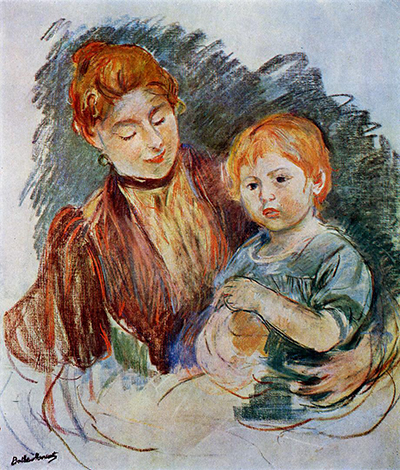Painted in 1894, Woman and Child by Berthe Morisot is in many ways a typical example of the artist's work. Focusing primarily on female domestic life, Morisot painted her daily experiences and drew inspiration from the private relationship between mother and daughter.
Woman and Child shows an affectionate portrait of a suburban mother and child, fashionably dressed in the Parisian garb of the era. Despite the undefined brushstrokes and whimsical colours, the painting is vivacious and the young child is clearly the star of the show. Painted towards the end of her life, it is likely that Morisot still drew inspiration from her own daughter, Julie, who by then was already a teenager. Morisot would often use her daughter as a muse, as well as other children of friends and family. Indeed, Morisot's daughter Julie would also grow up to become an artist.
Morisot was part of a group of Parisian painters known as the Impressionists. But unlike her contemporaries, such as Monet and Cezanne, Morisot is still relatively unknown. During her lifetime, her work was well received but not overtly successful. This was of little consequence to Morisot herself, however, as being born into a wealthy family meant that she did not have to rely on making money from her art. This may be partly why much of her work is introspective and focuses on everyday female activities as she is creating art for her own sake, not with the intention of pleasing others or commercial commissions.
Her work is often noted for its 'feminine charm' and her soft, sensual brushstrokes. Morisot often lamented that she was not considered as serious an artist because she was a woman and her decision to focus the majority of her work with woman as her subjects underlines her feminist stance. Much of Morisot's artwork is painted using watercolours and pastels, a method she learned early on in her training from mentor, Guichard. As her confidence and skill grew, Morisot began to also paint with oils. Her Impressionist background is clear from the undefined nature of her subjects and as her career progressed so did her interest in drawing and sketched with colour pencils and charcoals.
Her work is always delicate, feathery and feminine. There is a depth of motion to her artwork, a scene coming to life with blurred features and a wide range of colours. Her portraits often have a photographical layout, with Morisot herself becoming interested in photography alongside more traditional methods of capturing a subject. Woman and Child is currently not on display to the public and instead remains part of a private collection.




